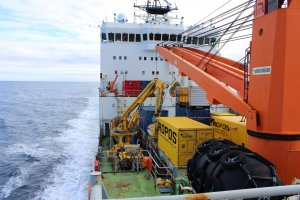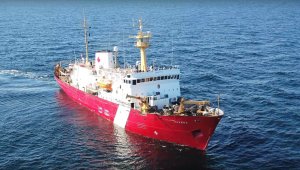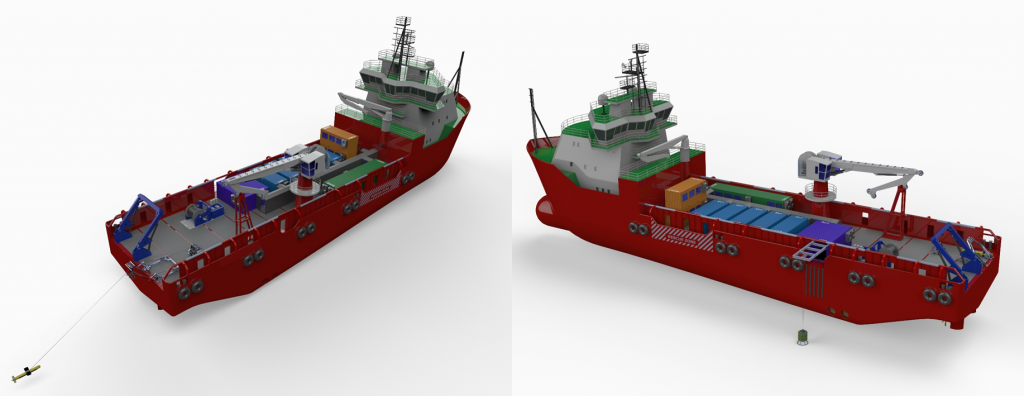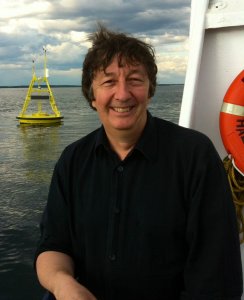
L’infrastructure modulaire de recherche océanique : une stratégie polyvalente, adaptable et abordable d’étude de la mer au Canada et dans le monde
– Par Doug Wallace (directeur scientifique, MEOPAR) et Doug Bancroft (président et PDG, Canadian Scientific Submersible Facility)–
Les navires de recherche restent une infrastructure essentielle sous-tendant de nombreux types d’études liées à l’océan. Les robots et les véhicules autonomes servent de plus en plus de mode de surveillance et appuient parfois la recherche axée sur les processus lorsque les capteurs adéquats existent. Cependant, il survient un nombre croissant de questions liées aux ressources océaniques et des fonds marins, ainsi qu’aux processus physiques, chimiques, biologiques et atmosphériques complexes, à la base des changements climatiques et de la biodiversité.
Pour répondre à ces questions, il faut que des équipes multidisciplinaires de spécialistes puissent accéder à l’océan avec des instruments de pointe, depuis des navires.
Les navires de recherche modernes sont des bâtiments complexes, conçus et construits sur mesure, et exploités exclusivement aux fins de recherche scientifique. Ils possèdent généralement des propriétés hautement spécialisées en matière de navigation, de tenue en mer, de réduction du bruit, de manipulation d’équipements, de systèmes de capteurs et d’échantillonnage, et ils embarquent des laboratoires de pointe.
Possédant le plus long littoral du monde et l’une des plus grandes zones d’exclusion économique, qui couvrent des écosystèmes hautement diversifiés, le Canada a des besoins importants en matière de navires de recherche. Pourtant, la flotte de navires de recherche du Canada, que détient et exploite principalement la Garde côtière canadienne, est en état de crise, en particulier sur la côte atlantique (Hughes et coll., 2019), de sorte que même le gouvernement du Canada est incapable d’y remplir sa mission (reportage de la CBC, déc. 2019). La situation s’avère particulièrement grave pour les grands navires nécessaires aux expéditions qui se dirigent vers des endroits éloignés et des régions soumises à des conditions météorologiques ou glacielles difficiles. C’est également ce type de navire qui accueille les grandes équipes multidisciplinaires de chercheurs et d’étudiants, nécessaires pour aborder les questions complexes de l’océan actuel. Dans l’ensemble, il demeure peu probable que la capacité actuellement prévue des navires de recherche océanique réponde à la demande existante et future.
Afin de définir et de résoudre adéquatement ce problème, MEOPAR (www.meopar.ca) a créé un groupe de travail national sur les navires de recherche. Celui-ci établira une vision de moyen à long terme (5 à 20 ans) des besoins futurs en matière de navires au Canada, pour la recherche côtière et en haute mer, tout en proposant des solutions pratiques pour résoudre la crise immédiate.
Quelles sont les solutions possibles à la crise des navires de recherche au Canada?
- Construire et exploiter plus de navires spécialisés axés sur la recherche;
- Compter sur la coopération d’autres pays et d’organismes étrangers, et sur l’accès à leurs navires dans le cadre d’expéditions ou d’affrètements conjoints;
- Développer une infrastructure modulaire de recherche océanique (MORI) à utiliser avec des navires de l’industrie maritime, ainsi qu’avec les futurs patrouilleurs extracôtiers et de l’Arctique de la GCC et de la marine, afin de les convertir, temporairement et au besoin, en navires de recherche de pointe. L’infrastructure modulaire pourrait comprendre :
- des laboratoires maritimes dans des conteneurs;
- des « capsules » d’hébergement et des salles de réunion pour les scientifiques et les techniciens;
- des véhicules sous-marins téléguidés et des véhicules sous-marins autonomes;
- des systèmes de lancement et de récupération des véhicules sous-marins téléguidés et autonomes;
- du matériel spécialisé d’échantillonnage (p. ex. des rosettes d’échantillonnage, des dispositifs de carottage, des filets, des stations météorologiques);
- des treuils et des structures en A;
- des grues et des cabestans destinés au déploiement et à l’exploitation d’équipement scientifique.
- sea-going containerized laboratories;
- accommodation “pods” and meeting rooms for scientists/ technicians;
- ROVs and AUVs;
- Launch and recovery systems (LARS) for ROV and AUVs;
- Specialized sampling gear (e.g. rosette samplers; coring devices; nets; meteorological stations);
- winches and A-frames;
- cranes; and
- capstans for deployment and operation of scientific gear.
Research vessels (RVs) remain critical infrastructure for many classes of ocean-related research. Robots and autonomous vehicles are used increasingly for monitoring and some process-oriented research when appropriate sensors are available. However, there are also a growing number of questions related to ocean and seafloor resources, as well as complex physical, chemical, biological and atmospheric processes critical to climate change and biodiversity, which require that multidisciplinary teams of researchers can access the ocean with highly sophisticated instrumentation, from vessels.
Modern RVs are complex, custom-designed ships that are built and operated exclusively for science. They tend to have highly specialised capability for navigation, seakeeping, noise reduction, equipment-handling, sensor and sampling systems and are equipped with sophisticated laboratories. Consequently, RVs are expensive to build and are operated exclusively by developed countries. A corollary is that although developing countries face pressing ocean research questions, independent access to modern RVs is usually out of their reach.
Canada is not a developing country but faces major challenges with respect to RV capacity. With the world’s longest coastline and one of the larger Economic Exclusion Zones spanning highly diverse ecosystems, Canada has major requirements for RVs. Yet Canada’s RV capacity, which is owned and operated primarily by the Canadian Coast Guard (CCG), is in a state of crisis, especially on the Atlantic coast (Hughes et al., 2019), so that even the Government of Canada is unable to meet its mission requirements there (CBC News report, Dec. 2019). Growing needs of other sectors (e.g. academia, Provincial governments, industry and NGOs) for vessel time across Canada are not being met. There are now serious limitations in terms of geographical/ temporal availability of vessels, flexibility of use, and multisectoral access to available capacity. Further, the available vessels are not necessarily state-of-the-art.
The situation is particularly acute for the larger vessels that are required for expeditions to remote locations and regions subject to challenging weather or ice conditions. This is also the vessel type required to accommodate the larger, multidisciplinary teams of researchers and students required to address complex questions of today’s ocean. Figure 1a shows that Canadian vessels of this type, including research-capable icebreakers essential for Arctic research, are the oldest in the world by far.

The RV situation is likely to deteriorate further over the near term as the oldest vessels undergo refits and repair, or are taken out of service permanently. Recent and planned new builds under the National Shipbuilding Strategy (NSS) are sufficient only to replace retiring CCG vessels required by the Department of Fisheries and Oceans (DFO) for its fishery and ecosystem management mandate. The three replacement “offshore fishery and science vessels” have berths for only 13 researchers, which precludes their use for multidisciplinary research, even if vessel time were available.
The situation on Canada’s Atlantic coast is particularly acute. Ocean research in this region depends on the CCGS Hudson, which was commissioned in 1962, has undergone multiple refits, and is now far beyond its life expectancy and no longer meets requirements of modern ocean research. Although a replacement for CCGS Hudson is part of the NSS, construction has been deferred (CBC News report, Feb. 2019), and it will not be ready for use for many years. On a more positive note, additional naval and CCG Arctic and Offshore Patrol Ships (AOPS) are under construction or planned, and may be made available for research. However, these vessels were not designed for science so that their utility is unknown. They will also not be available for several years, and will have other important, competing uses. Overall, currently planned capacity of ocean-going research vessels is unlikely to meet existing and projected demand.
To help better define and address this problem, MEOPAR (www.meopar.ca) has established a National Research Vessel Task Team with representation from end-users and other interested parties across Canada. The Task Team will develop a vision for the medium to long-term (5-20 years) future of Canada’s vessel needs for both coastal and offshore research, while proposing practical solutions to address the immediate capacity crisis. It will focus especially on the larger vessels required for offshore research, and include consideration of the needs of users in academia and the private sector as well as different levels of government. This document is intended as an input into discussions by the Task Team.
What are possible solutions to Canada’s RV capacity crisis?
a) Build and operate more dedicated, specialised RVs;
b) Rely on cooperation with foreign nations/ institutions and their vessels via shared cruises and/or charters;
c) Develop modular ocean research infrastructure (MORI) for use with available, “workhorse” industry vessels as well as future CCG and naval AOPS, in order to convert them into sophisticated RVs on a temporary, “as-needed basis”.
Option a) may be unrealistic given the scale of the need across Canada. Further, it would take years to realize, and involve massive cost as well as a major, long-term commitments to support that might outstrip the ocean research community’s capacity. It also would be inconsistent with the National Shipbuilding Strategy, which as noted above is now just delivering new ships to the CCG and RCN.
Option b) is used increasingly, by default, by academic, private-sector and government users. It has some advantages in mitigating near-term deficits, but has several disadvantages over the medium-to-longer term. The disadvantages include dependence on foreign countries, which in turn risks restricting Canada’s sovereign ability to access its own waters for research and pursuit of Canadian priorities. The ability to charter or share a foreign vessel may involve legal and financial arrangements beyond the reach of many Canadian institutions and could risk legal challenge from Canadian ship operators. Use of foreign vessels typically involves long transits for repositioning, which limits flexibility and raises costs. Sharing of vessels could involve legal restrictions on Canadians (e.g. involving intellectual property or publication rights). Access to foreign vessels will, typically, be restricted by the priorities of the foreign owners, which might limit Canadians’ vessel access to times of year with less interest/demand.
Option c) MORI is original and would require fundamentally new approaches, but represents a scalable, flexible solution to RV availability that might work well for Canada. It is compatible with flexible scientific use of Arctic and Offshore Patrol Ships (AOPS) and offers options for Canadian private sector involvement. Significantly, the MORI concept could alleviate Canada’s ocean-going RV capacity crisis in the near future, through use of existing and planned, capable vessels that are Canadian owned and operated. This option would require a national approach for accessing and coordinating vessel time and MORI infrastructure, however such a system is probably required whatever solutions are implemented.
What is the MORI concept?
The MORI concept is to deploy “modular, portable infrastructure,” temporarily, on industry “workhorse” vessels, and other “non-specialised vessels” (e.g. AOPS), in order to convert them for use as sophisticated, capable RVs. The modular infrastructure could include:

The infrastructure should be designed for mobility, and flexible deployment on diverse vessel types. In a departure from existing use of containerized systems (e.g. container labs), modules would be designed to work together as an interoperable system in terms of data transfer, services, communications, logistics, etc. The current Technology Readiness Level (TRL) of MORI components varies from 6 to 9, with the former being sea-going labs, the latter being ROV and AUV operations conducted using “plug-and-play” sea-going containers.
The vessels used with MORI should ideally have space for mounting of over-the-side sampling gear including A-frames, winches, cranes, etc. as well as for 10-foot, 20-foot and/or 40-foot standard containers. For offshore research, vessels should be able to accommodate teams of at least 24 researchers: either within on-board accommodation or in accommodation modules. In order to support many modern scientific operations, the vessels should have dynamic positioning (DP).

Industry-owned platform supply vessels (PSVs) and government-owned AOPS both have potential for temporary conversion to RVs using MORI. PSVs are workhorse vessels, widely used in the offshore industry, and are often designed to be multipurpose with open deck space suitable for container installation. With a general lack of superstructure it should normally be possible to install gear for over-the-side operations. Most such vessels have DP, and many have “hotel” accommodation for transportation of crews to/from offshore platforms. Some have specialized cranes and, even, their own ROVs. Ideally such vessels would allow for underway sampling of clean surface water (via a sea-chest) as well as installation of hull-mounted sensors.
The AOPS have space for containers and berth space is available for use by teams of researchers. While not designed for science-use, and presently without DP capability, the potential of these new vessels should be maximized, and the MORI concept is fully compatible with their flexible use.
Commercial Opportunities
By extension, MORI offers a means of supporting modern ocean research by many countries worldwide that do not currently have access to specialized RVs, including developing countries. Successful demonstration in Canada of a fully developed MORI concept could open commercial possibilities for deployment of the concept in other markets worldwide.
Projected Use
Assuming required MORI components were maintained and made available via a common pool, diverse users (e.g. government agencies and/or Universities), could enter into charter agreements with vessel owners and/or other operators for the periods of time required for their research. As noted, a national system for accessing vessel time and sharing of MORI would be required. Sea time on commercial vessels could be made available through long- or short-term charters and sea time on CCG and RCN AOPS would require a mechanism to allow for coordinated access, including by non-government users.
The innovation required to implement MORI should not be underestimated: modern RVs are equipped permanently with highly sophisticated laboratories and state-of-the-art equipment. Conversion of these shipboard installations to a modular, interoperable, portable and safe system will require originality and innovation as well as extensive testing. However, if Canada can demonstrate the concept and use it to address its national crisis of RV capacity, the system will be attractive for use elsewhere, especially by countries that do not have their own RVs (which is the situation of most countries in the world).
Fig. 4 depicts a typical PSV configured with MORI for multidisciplinary ocean-going research. We envision this type of vessel being capable of supporting highly-advanced research, involving teams of 20 to 40 scientists and technicians working on-board (depending on vessel size), as is common on the custom, ocean-going, global- and ocean-class RVs operated by France, Germany, China, UK, USA, Japan, etc.

Next Steps
The most important next step is to convene a Canada-wide discussion about RV capacity needs and potential solutions. The MORI concept can be one item for discussion by the National Research Vessel Task Team, but the authors are aware that a mix of solutions will likely be required. Involvement of the Canadian private sector in the development of efficient and effective solutions, including MORI, should be considered and encouraged.
Acknowledgements
Thanks to Dan Kehoe for the PSV drawings and Rodrigo Menafra, Bridget Graham and the MEOPAR staff for support.
References
Hughes, J. 2019. Assessment of Needs and Opportunities for Research Vessel Use in Atlantic Canada. Report commissioned by the Marine Environmental Observation, Prediction and Response Network (MEOPAR). Published on February 6th, 2019. Halifax, Nova Scotia, Canada.
CBC news report, December 9, 2019. “More problems surface in troubled refit of coast guard vessel”;
CBC news report, February 5, 2019, “Ottawa pushes navy’s planned supply ships to the front of the construction queue”
Nieuwejaar et al. (2019) Next Generation European Research Vessels: Current Status and Foreseeable Evolution. Heymans et al. [Eds.] Position Paper 25 of the European Marine Board, Ostend, Belgium. 140pp. ISBN: 978-94-92043-79-5 DOI: 10.5281/zenodo.3477893
About the Authors
Dr. Douglas Wallace

Dr. Wallace is Canada Excellence Research Chair (CERC) Laureate in Ocean Science and Technology as well as Canada Research Chair (Tier 1) in Ocean Science and Technology in the Oceanography Department at Dalhousie University in Halifax, NS, Canada. Dr. Wallace also serves as Scientific Director of the Marine Environmental Observation Prediction and Response Network (MEOPAR; www.meopar.ca), a ca. $5 million/year national research network focussed on marine risk. Prior to his appointment at Dalhousie, Dr. Wallace was professor of marine chemistry at the Helmholtz Centre for Ocean Research Kiel (GEOMAR). There, he also served as deputy director and head of the Marine Biogeochemistry Research Division. He holds a Ph.D in chemical oceanography from Dalhousie University and a bachelor’s degree in environmental science from the University of East Anglia, United Kingdom. Dr. Wallace spent more than a decade working as a scientist at the Brookhaven National Laboratory in the United States. He has made significant scientific contributions to his field through the Intergovernmental Panel on Climate Change, and the US Department of Energy, where he developed the first survey to measure the global distribution of fossil-fuel carbon in the oceans. Dr. Wallace has contributed to building a number of multidisciplinary research teams and programs in the USA, Germany, Europe, West Africa and Canada. His research interests focus on carbon cycle and air-sea exchange of gases.
Douglas Bancroft, OMM CD MSc

Douglas Bancroft joined the Meteorological Service of Canada, Environment Canada in 1981, and then served progressively in several weather centres. Highlights included Officer-in-Charge of the west coast Meteorology and Oceanography Centre; and later Director of the Canadian Ice Service, and Co-Director of the Canada-United States North American Ice Service. Doug also served in Fisheries and Oceans Canada in 2000 as a Senior Science Advisor, and then national Director of Oceanography and Climate Science. Doug was promoted to Director General of the Canada Center for Remote Sensing with Natural Resources Canada in 2010. In 2013 Doug retired from the Public Service and transitioned to the Private Sector and academia. Today he is President and CEO of the Canadian Scientific Submersible Facility; and serves on three Board of Directors. He is also a Visiting Scientist/Sessional Instructor at the School of Earth and Ocean Science, University of Victoria. In parallel to his civil career, Doug served of the Royal Canadian Navy (reserve) for thirty-eight years. He has commanded six HMC Ships for various periods at sea, Port Security Unit Four and HMCS CARLETON (Canada’s largest naval reserve division). Doug holds a BSc in Physics, a specialised undergraduate diploma in meteorology, and an MSc in Physical Oceanography.
More Like This:
Doug Bancroft, Doug Wallace, équipes multidisciplinaires de spécialistes, MEOPAR, navires de recherche